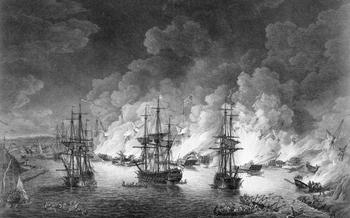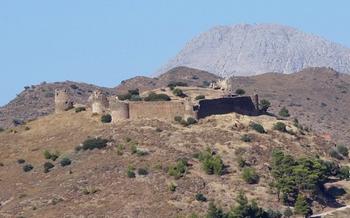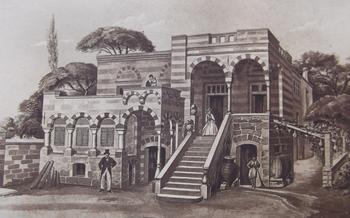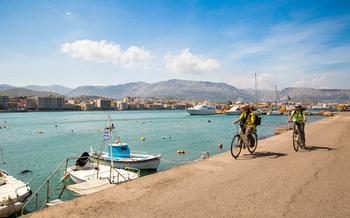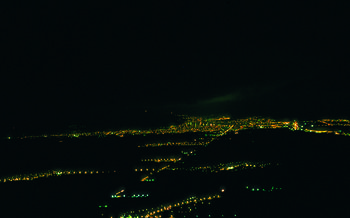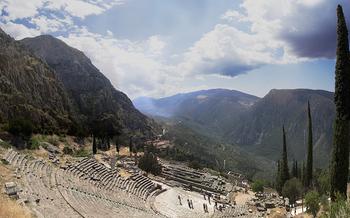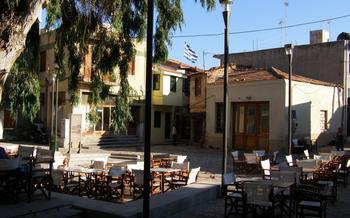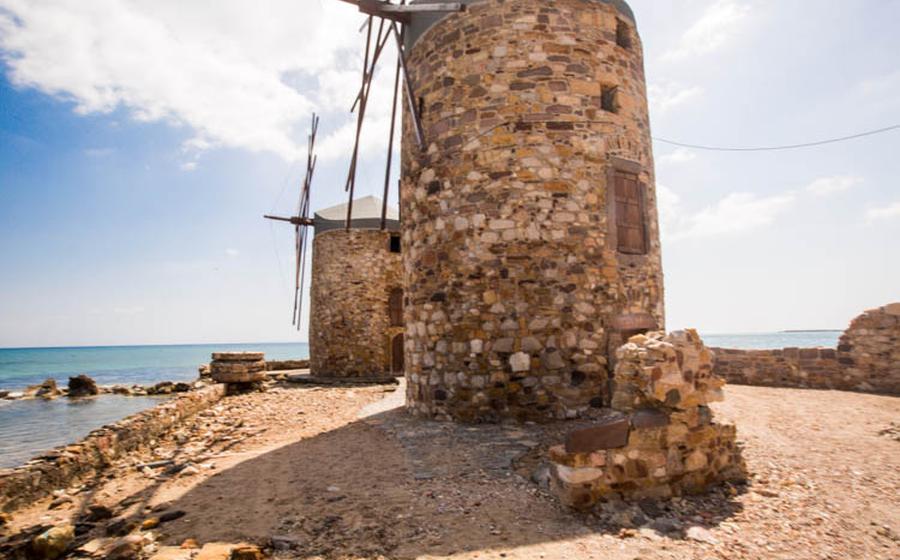
Windmills of Chios
- The Windmills of Chios: Symbol of the Island's Past and Present
- Location and Accessibility
- Getting to Chios
- Transportation Options on the Island
- Exploring the Windmill Villages
- The History of Windmills in Chios
- The Construction of the Windmills
- The Internal Mechanisms of the Windmills
- The Millers of Chios
- The Windmills and the Production of Flour
- Visiting the Windmills Today
- The Windmills as a Cultural Heritage Site
- The Windmills in Popular Culture
- The Windmills and Tourism
- Other Notable Windmills in Greece
- Preserving the Windmills for Future Generations
- Insider Tip: The Best Time to Visit the Windmills
The Windmills of Chios: Symbol of the Island's Past and Present
History of the windmills
The iconic windmills of Chios have a long and fascinating history that dates back to the Middle Ages. The first windmills were constructed on the island during the 14th century by the Genoese, who ruled Chios for over two centuries. These early windmills were simple in design, consisting of a round tower and a conical roof that rotated to catch the wind. Over time, the windmills evolved and became more sophisticated, with the addition of multiple sails and complex mechanisms for grinding wheat. By the 19th century, there were over 100 windmills operating on Chios, making it one of the most important milling centers in the Mediterranean.
Architectural features
The windmills of Chios are renowned for their unique architectural features. Each windmill consists of a tall, cylindrical stone tower with a conical roof that rotates to catch the wind. The towers are typically whitewashed, with red or blue trim. The roofs are made of wood or thatch, and are covered with a layer of tar to protect them from the elements. The windmills also have a set of sails, which are made of canvas or cotton. The sails are attached to a central shaft, which is connected to a millstone inside the tower.
Symbolism and cultural significance
The windmills of Chios are not just historical monuments; they are also symbols of the island's past and present. The windmills have been featured in countless works of art, literature, and music, and they have become a beloved symbol of Chios. The windmills are also a reminder of the island's rich milling tradition, which has played an important role in the local economy for centuries.
Location and Accessibility
The windmills of Chios are located in various villages across the island. The highest concentration of windmills can be found in the villages of Mesta, Volissos, Pyrgi, and Emporios. These villages are situated in the southern part of Chios, offering breathtaking views of the Aegean Sea and the surrounding countryside.
Getting to Chios
Chios is easily accessible by air and sea. There are direct flights to Chios International Airport (CHQ) from several major cities in Greece and Europe. Alternatively, visitors can take a ferry from the port city of Piraeus in Athens. The journey by ferry takes approximately 8 hours.
Transportation Options on the Island
Once on the island, there are several options for getting around. Rental cars and taxis are readily available, allowing visitors to explore the island at their own pace. For those who prefer a more active mode of transportation, bicycles can be rented from local shops. Additionally, there is a well-established public bus network that connects the major towns and villages on the island.
Exploring the Windmill Villages
The villages of Chios that boast the highest concentration of windmills are Pyrgi, Mesta, and Olymbi. Each village possesses its own unique characteristics that set it apart from the others.
Pyrgi is renowned for its distinctive black-and-white geometric patterns adorning the facades of its houses, a style of architecture known as xysta. These intricate designs are said to have originated from the island's seafaring past, where sailors would create similar patterns on their sails to ward off evil spirits.
Mesta, on the other hand, is a fortified village that exudes a medieval charm. Its narrow, winding streets are lined with stone houses and defensive towers, creating a labyrinthine atmosphere. Mesta's strategic location atop a hill offers breathtaking views of the surrounding countryside and the Aegean Sea.
Olymbi is a picturesque village nestled amidst lush greenery and olive groves. It is home to a cluster of well-preserved windmills that stand as silent sentinels, overlooking the tranquil landscape. Olymbi's traditional architecture, characterized by stone-built houses and cobblestone streets, adds to its timeless allure.
In these windmill villages, visitors can immerse themselves in the local culture and traditions. The villagers are known for their warm hospitality and are always eager to share stories and anecdotes about the history and significance of the windmills.
The History of Windmills in Chios
The Role of Windmills in Chios's Economy: Windmills played a pivotal role in the economy of Chios, contributing to its prosperity and prominence. They were instrumental in grinding wheat and other grains into flour, which was then used to produce bread, pasta, and other food staples. The windmills' efficiency and productivity allowed Chios to become a major exporter of flour and wheat products throughout the Mediterranean region. This flourishing trade brought significant wealth and prosperity to the island, making it a hub of commerce and trade.
Evolution of Windmill Technology: The windmills of Chios underwent several technological advancements over the centuries. Initially, they were simple structures with rudimentary mechanisms, but gradually, they incorporated innovative features that enhanced their efficiency and productivity. The introduction of gears and other mechanical components allowed for better control and regulation of the grinding process. The sails were also refined, increasing their aerodynamic efficiency and enabling the windmills to harness even the slightest breeze.
Impact on the Island's Development: The windmills had a profound impact on the development of Chios, shaping its economy, society, and culture. They provided a reliable and sustainable source of power, which enabled the island to become a major agricultural producer. The flour industry flourished, creating employment opportunities and boosting the local economy. The windmills also became a symbol of Chios's ingenuity and resourcefulness, attracting visitors and merchants from far and wide.
The Construction of the Windmills
The windmills of Chios are remarkable examples of traditional architecture, showcasing the ingenuity and craftsmanship of their builders. Constructed using locally sourced materials, the windmills blend seamlessly into the island's landscape, standing as testaments to the harmonious relationship between humans and their environment.
Materials and Techniques
The windmills of Chios were primarily constructed using stone, wood, and reeds. Stone formed the foundation and lower walls, providing stability and protection against strong winds. Wood was utilized for the upper floors, doors, and windows, ensuring structural integrity while allowing for flexibility and movement. Reeds, a versatile and locally abundant material, were skillfully woven to create sturdy roofs that resisted the harsh elements.
Architectural Styles and Influences
The windmills of Chios exhibit a unique architectural style that reflects the island's rich cultural heritage. While sharing common features with windmills found in other parts of Greece, they also incorporate elements of Byzantine and Ottoman architecture. The cylindrical shape of the towers, the conical roofs, and the arched doorways are all indicative of Byzantine influence, while the use of domes and minarets reveals the impact of Ottoman rule.
Preservation and Restoration Efforts
In recent years, significant efforts have been undertaken to preserve and restore the windmills of Chios. Recognizing their historical and cultural significance, local authorities and organizations have collaborated to safeguard these iconic structures. Restoration projects have focused on repairing damaged stonework, replacing weathered wooden components, and reinforcing structural elements to ensure the windmills' longevity.
By preserving and restoring these architectural treasures, the community of Chios is not only honoring its past but also safeguarding a tangible link to its identity and traditions.
The Internal Mechanisms of the Windmills
The windmills of Chios are intricate structures that showcase the ingenuity of their creators. Each windmill consists of several key components that work together to harness the power of the wind and grind wheat into flour.
At the heart of the windmill is the wind rose, a rotating mechanism that captures the wind and directs it into the sails. The sails are attached to a horizontal shaft which, when turned by the wind, drives the millstones. The millstones are two large, circular stones that crush the wheat into flour.
The upper millstone is fixed, while the lower millstone is movable. The distance between the two stones can be adjusted to control the coarseness of the flour. The rotation of the lower millstone is powered by a gear system that is connected to the horizontal shaft.
The grain hopper is located at the top of the windmill. It feeds the wheat into the millstones at a controlled rate. The flour bin is located at the bottom of the windmill and collects the flour produced by the grinding process.
The internal mechanisms of the windmills are a testament to the engineering skill of the people of Chios. These intricate systems have been preserved and restored, allowing visitors to gain a glimpse into the workings of these iconic structures.
The Millers of Chios
The millers of Chios played a vital role in the community, serving as the guardians of the island's staple food source. They possessed a unique set of skills and knowledge, passed down from generation to generation, that enabled them to operate and maintain the windmills efficiently. The millers were responsible for grinding wheat into flour, a process that required precision and expertise. They adjusted the millstones to achieve the desired fineness of the flour, and monitored the wind conditions to ensure optimal performance of the windmills.
The millers were highly respected members of the community, and their work was considered an essential service. They were often sought after for their advice and assistance, and their opinions were valued in matters related to agriculture and food production. The millers also played a social role, as their windmills were often gathering places for locals to exchange news and stories.
However, the life of a miller was not without its challenges. The work was physically demanding, and the millers had to endure long hours and harsh weather conditions. They also faced the risk of accidents, as the windmills were complex machines with moving parts. Despite these challenges, the millers of Chios were dedicated to their craft, and their work contributed significantly to the island's economy and food security.
The Windmills and the Production of Flour
The role of the windmills in the food industry
The windmills of Chios played a crucial role in the island's food industry, particularly in the production of flour. Flour has been a staple food in Greece for centuries, and the windmills provided an efficient and reliable means of grinding wheat into flour. Before the introduction of windmills, flour was produced using hand-operated querns, a laborious and time-consuming process. The windmills revolutionized flour production, allowing for the mass production of flour to meet the growing demand of the island's population.
Traditional methods of flour production
The traditional method of flour production in Chios involved several stages. First, the wheat was harvested and cleaned to remove impurities. Then, it was transported to the windmills, where it was stored in large granaries. When needed, the wheat was poured into a hopper at the top of the windmill. The hopper released the wheat in a controlled manner into the millstones, which were made of hard stone and rotated against each other to grind the wheat into flour. The ground flour was then collected in a bin below the millstones.
The significance of flour in Greek cuisine
Flour is an essential ingredient in Greek cuisine, used in a variety of dishes such as bread, pastries, and pasta. The flour produced by the windmills of Chios was renowned for its high quality and flavor, and was used by local families and bakeries to create delicious and nutritious food. The windmills thus played a vital role in sustaining the island's culinary traditions and providing nourishment to its people.
Visiting the Windmills Today
The windmills of Chios welcome visitors with open arms, inviting them to explore their rich history and architectural wonders. Whether you're a history buff, an architecture enthusiast, or simply someone who appreciates the beauty of these iconic structures, there are several ways to experience the windmills up close.
Opening Hours and Admission Fees
Most of the windmills in Chios are open to the public during daylight hours. Admission fees are typically minimal, and some windmills offer guided tours for a more in-depth experience. It's advisable to check with the local tourist information center for specific opening hours and fees.
Guided Tours and Self-Guided Exploration
Guided tours are available for those who want to learn more about the history, construction, and operation of the windmills. These tours are led by knowledgeable guides who can provide insights into the lives of the millers and the importance of the windmills to the island's economy and culture.
For those who prefer to explore at their own pace, self-guided tours are also an option. Maps and information boards are often available at the windmills, allowing visitors to learn about the structures and their history independently.
Photography Opportunities
The windmills of Chios offer a treasure trove of photographic opportunities. With their picturesque settings and unique architecture, these iconic structures make for stunning photographs. The best time to capture the windmills in all their glory is during sunrise or sunset when the sky is painted with vibrant colors.
The Windmills as a Cultural Heritage Site
The windmills of Chios have been recognized by UNESCO as a World Heritage Site for their outstanding universal value. They are considered to be a unique and remarkable example of traditional Greek architecture and engineering, and they have played a vital role in the island's economic and cultural development. The preservation of these windmills is of great importance, not only for their historical and cultural significance, but also for the identity of the island of Chios. The local authorities and communities are dedicated to protecting and promoting this exceptional cultural heritage site for future generations to appreciate and enjoy.
The Windmills in Popular Culture
The windmills of Chios have been immortalized in popular culture, becoming a symbol of the island's rich history and cultural heritage. Celebrated in literature, art, and music, these iconic structures have inspired countless creative minds.
One notable literary work that features the windmills is "The Windmills of Mykonos" by the Greek author Stratis Myrivilis. Published in 1935, this novel tells the story of a young man who returns to his home island of Mykonos after studying abroad. He finds himself struggling to reconcile his modern education with the traditional values and customs of his homeland, symbolized by the windmills.
In the realm of art, the windmills have been depicted in paintings, sculptures, and even graffiti. One famous painting is "The Windmills of Chios" by the Greek artist Yannis Tsarouchis. Created in 1937, this masterpiece captures the serene beauty of the windmills against the backdrop of the Aegean Sea.
Music has also played a role in elevating the status of the windmills in popular culture. The Greek composer Mikis Theodorakis wrote a song called "The Windmills", which became a popular anthem during the 1970s. The song evokes the spirit of resistance and resilience, using the windmills as a metaphor for the Greek people's struggle for freedom.
Beyond these specific works of art, the windmills have become a symbol of Chios's identity, representing the island's unique character and its connection to the past. Their presence in popular culture ensures that the legacy of these iconic structures will continue to inspire and captivate generations to come.
The Windmills and Tourism
The windmills of Chios are a major tourist attraction, drawing visitors from around the world. Their unique beauty and historical significance make them a must-see for anyone visiting the island. Tourism plays a vital role in the local economy, providing income for businesses and residents. The windmills contribute to this by attracting visitors who spend money on accommodation, food, souvenirs, and tours.
Economic Benefits of Tourism
Tourism is a major source of income for the island of Chios. The windmills are one of the most popular tourist attractions, attracting thousands of visitors each year. These visitors spend money on accommodation, food, souvenirs, and tours, which helps to support the local economy. In addition, tourism creates jobs for local people, such as tour guides, museum staff, and souvenir shop owners.
Responsible Tourism Practices
As tourism increases, it is important to ensure that the windmills and the surrounding environment are protected. This can be achieved through responsible tourism practices, such as staying on designated paths, respecting the property of local residents, and avoiding littering. Visitors should also be aware of the cultural significance of the windmills and act respectfully.
In conclusion, the windmills of Chios are a valuable cultural heritage site that attracts visitors from around the world. Tourism plays a vital role in the local economy, providing income for businesses and residents. It is important to promote responsible tourism practices to ensure that the windmills and the surrounding environment are protected for future generations.
Other Notable Windmills in Greece
While Chios is renowned for its windmills, other regions in Greece also boast impressive windmill structures. The island of Mykonos, for instance, features charming windmills that dot the landscape, contributing to its iconic scenery. These windmills, though smaller in size compared to those in Chios, have become a symbol of the island's rich maritime history.
On the mainland, the region of Mani in the Peloponnese is home to a significant number of windmills. These windmills, typically cylindrical in shape with conical roofs, were once used to grind wheat and other grains. Today, they stand as reminders of Mani's agricultural heritage and serve as popular tourist attractions.
The island of Crete, known for its diverse landscapes and historical sites, also features several windmills. These windmills, often found in the countryside, have been restored and converted into museums, providing visitors with a glimpse into the island's traditional way of life.
Each region of Greece offers unique windmill experiences, showcasing the country's rich cultural heritage and connection to these iconic structures. Whether you're exploring the windmills of Chios, Mykonos, Mani, or Crete, you'll discover the enduring legacy of these architectural wonders.
Preserving the Windmills for Future Generations
The windmills of Chios are a precious cultural heritage site, and preserving them for future generations is of utmost importance. Ongoing restoration and conservation efforts are underway to ensure that these iconic structures continue to stand the test of time.
These efforts involve careful assessment and repair of the windmills' structural integrity, using traditional techniques and materials. Regular maintenance and upkeep are also carried out to prevent further deterioration.
However, the preservation of the windmills faces several challenges. The harsh weather conditions on the island, including strong winds and salty air, can cause damage to the structures over time. Additionally, the availability of skilled craftsmen with the necessary expertise in traditional windmill construction is limited.
Local communities and organizations play a crucial role in preserving the windmills. They actively participate in restoration projects, providing support and resources. Educational programs and initiatives are also implemented to raise awareness among the younger generation about the importance of preserving these cultural treasures.
By addressing these challenges and working together, we can ensure that the windmills of Chios continue to stand as a testament to the island's rich history and cultural heritage, inspiring and captivating visitors for generations to come.
Insider Tip: The Best Time to Visit the Windmills
To fully immerse yourself in the beauty of the windmills and capture stunning photographs, plan your visit for the early morning or late afternoon when the light is at its most flattering. This will allow you to take advantage of the warm, golden hues that illuminate the structures, creating a picturesque scene.
To avoid the crowds that often flock to the windmills during the peak tourist season, consider visiting during the shoulder months (May-June and September-October) when the weather is still pleasant but the crowds are smaller. Alternatively, if you're seeking a serene and tranquil experience, visit during the off-season (November-April) when you'll have the windmills virtually to yourself.
Visiting the windmills during different seasons offers unique experiences. In the spring, the surrounding landscape bursts into bloom, creating a vibrant tapestry of colors that contrasts beautifully with the weathered stone of the windmills. During the summer, the windmills provide a welcome respite from the heat, offering a cool and shady spot to relax and soak in the history. In the autumn, the changing colors of the leaves add a touch of melancholy to the scene, creating a nostalgic atmosphere. And in the winter, the windmills stand tall and proud against the backdrop of a snow-capped landscape, offering a magical and enchanting sight.
